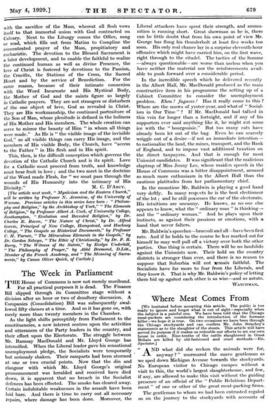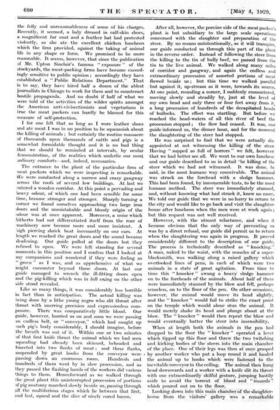Where Meat Comes From
[We hesitated before accepting this article. The public is too ready to ignore and forget what is out of sight—especially when the subject is a painful one. We have been told that the Chicago meat-packers are considering the introduction of the humane killer—we hope it is true. On two occasions we have been through the Chicago stockyards and can confirm Mr. John Strachey's statements as to the slaughter of the steers. This article will have served its purpose if it makes us redouble our efforts to set our own house in order. Nine-tenths of the cattle slaughtered in Great Britain are killed by old-fashioned and cruel methods.—En. Spectator.] " AND what did she reckon the animals were for, anyway ? " murmured the suave gentleman as we sped down Michigan Avenue towards the stockyards. No European visitor to Chicago escapes without a visit to this, -the world's largest slaughterhouse, and few, if any, are allowed to make this visit without the guiding presence of an official of the " Public Relations Depart- ment " of one or other of the great meat-packing firms.
The gentleman to whom we had been entrusted regaled us on the journey to the stockyards with accounts of the folly and unreasonableness of some of his charges. Recently, it seemed, a lady dressed in calf-skin shoes, a magnificent fur coat and a feather hat had protested violently, as she ate the excellent chicken luncheon which the firm provided, against the taking of animal life in any shape or form. We promised to be more reasonable. It seems, however, that since the publication of Mr. Upton Sinclair's famous " exposure " of the stockyards, the meat-packing firms have become exceed- ingly sensitive to public opinion ; accordingly they have established a " Public Relations Department." That is to say, they have hired half a dozen of the ablest journalists in Chicago to work for them and to counteract hostile propaganda. And no doubt if half of what we were told of the activities of the wilder spirits amongst the American anti-vivisectionists and vegetarians is true the meat packers can hardly be blamed for this .
measure of self-protection.
I for one felt that so long. as I wore leather shoes and ate meat I was in no position to be squeamish about the killing of animals ; but certainly the routine massacre of thousands upon thousands of cattle and pigs is a somewhat formidable thought and it is no bad thing that we should be reminded at intervals, by ocular demonstration, of the realities which underlie our most ordinary comforts—and, indeed, necessaries.
The entrance to the plant of the particular firm of meat packers which we were inspecting is remarkable. We were conducted along a narrow and crazy gangway across the roofs of several low buildings. At last we entered a wooden corridor. At this point a pervading and heavy odour, of which one had been sensible for some time, became stronger and stronger. Sharply turning a corner we found ourselves approaching two large iron doors and the unmistakable and bloody origin of the odour was at once apparent. Moreover, a noise which hitherto had not differentiated itself from the roar of machinery now became more and more insistent. A high piercing shriek beat incessantly on our ears. At length we reached the great doors and the sound became deafening. Our guide pulled at the doors but they refused to open. We were left standing for several moments in this position and I confess that I looked at my companions and wondered if they were feeling as ••• green " as I was, and as apprehensive of what we Might encounter beyond those doors. At last our guide managed to wrench the ill-fitting doors open and the pig-killing which was in full swing on the other side stood revealed.
Like so many things, it was considerably less horrible in fact than in anticipation. The actual killing was being done by a lithe young negro who slit throat after throat with unerring precision and expressionless com- posure. There was comparatively little blood. Our guide, however, hurried us on and soon we were passing ari endless belt, or " conveyor," whiCh had caught up each pig's body considerably, I should imagine, before the breath was out of it. Within one or two minutes of that first knife thrust the animal which we had seen squealing had already been skinned, beheaded and bisected into two flanks of meat ; and these flanks, suspended by great hooks from the conveyor were flossing doWn an enormous . room. Hundreds and hundreds of them went by in slow procession, and as they passed the flashing hands of the workers did various things to 'them. Henceforward as we walked through the great plant this uninterrupted procession of portions of pig anatomy marched slowly beside us,,passing through all the multifariOus stages which he between that 'first, and last, squeal and the slice of nicely cured bacon. After All, however, the porcine side of the meat packer's plant is but subsidiary to the large scale operations concerned with the slaughter and preparation of the steer. By no means unintentionally, as it will transpire, our guide conducted us through this part of the plant in the reverse order. Instead of following the steer from the killing to the tin of bully beef, we paSsed from the tin to the live animal. We walked along many miles of corridor and gangway, and again the endless and extraordinary procession of assorted portions-of meat flowed beside us ; but this time we walked parallel but against it, up-stream as it were, towards its source. At one point, rounding a corner, I suddenly encountered, moving slowly and steadily by, just at the level of my own head and only three or four feet away from it, a long procession of hundreds of the decapitated heads of bullocks. The effect was startling. But before we reached the head-waters of all this river of beef the procession stopped ; the flow had ceased. It was, our guide informed us, the dinner hour, and for the moment the slaughtering of the steer had stopped.
He was surprised to find that we were actually dis appointed at not witnessing the killing of the steer Having " supped so full of horrors " we felt, however, that we had better see all. We went to our own luncheor 'and our guide described to us in detail he killing of the 'steer which we had not 'witnessed. It was done, he said, in the most inunane way conceivable. The animal was struck on the forehead with a sledge hammer. This had been found, by innumerable tests, to be the most humane method. The steer was immediately stunned, and, without knowing what had struck it, knew no more. We told our guide that we were in no hurry to return to 'the city and would like to go back and visit the slaughter- house after luncheon when the men were at work again ; but this request was not well received.
However, with the utmost reluctance, and when it became obvious that the only way of preventing us was by a direct refusal, our guide did permit us to return when the slaughtering was again in progress. It proved considerably different to the description of our guide. The process is technically described as " blocking." A man, naked to the waist, with the muscles of a super- blacksmith, was walking along a raised "gallery which overlooked lines of pens, in each of which were two animals in a state of great agitation. From . time to time this " knocker " swung a heavy sledge hammer on to the foreheads of the animals. About half of them were immediately stunned by the blow and fell, perhaps senseless; on to the floor of the pen. On other occasions, however, the animal would move its head slightly, and the " knocker " would fail to strike the exact point on the temple which would alone stun the animal. It would merely shake its head and plunge about at the blow. The " knocker " would then repeat the blOw and would eventually batter the steer into insensibility.
When at length both the animals in the pen had , dropped to the floor the " knocker " operated a lever Which tipped up this floor and threw the two twitching and kicking bodies of the steers into the main chamber of the place. One of their legs was then at once grasped • by another worker who put a loop round it and hauled the animal up to hooks which were taitened to the inevitable conveyor in the ceiling. The animal then hung head downwards and a worker with a knife slit its throat with one extraordinarily skilful gesture, jumping hastily aside to avoid the torrent, of blood and " innards ". which poured out on to the floor.. ' Looking down into this main chamber of the slaughter. house from the visitors' gallery was a remarkable experience. The workers, some black, some white, waded about on a floor which was ankle deep in blood. They were, of course, covered from head to foot in blood and their faces wore the curious impassive expression of men engaged hour upon hour in unpleasant and extremely heavy manual labour. The whole spectacle, framed in the curious and rather ramshackle wooden structure of the slaughterhouse, was Hogarthian. I understood why our anxious guide had been somewhat unwilling that we should witness it.
No doubt the vegetarian would have a right to be much shocked. For myself, I found that, so far as the animals were concerned, I was not so much outraged as by the conditions of the workers who are employed in this grim task. It is, to my mind, entirely nece-ary to kill animals for human needs, although I should have thought that decidedly more humane methods could be devised than-those in use at Chicago. There is nothing being done there, however, which could not be paralleled in Great Britain.
JOHN STRACHEY..
























































 Previous page
Previous page